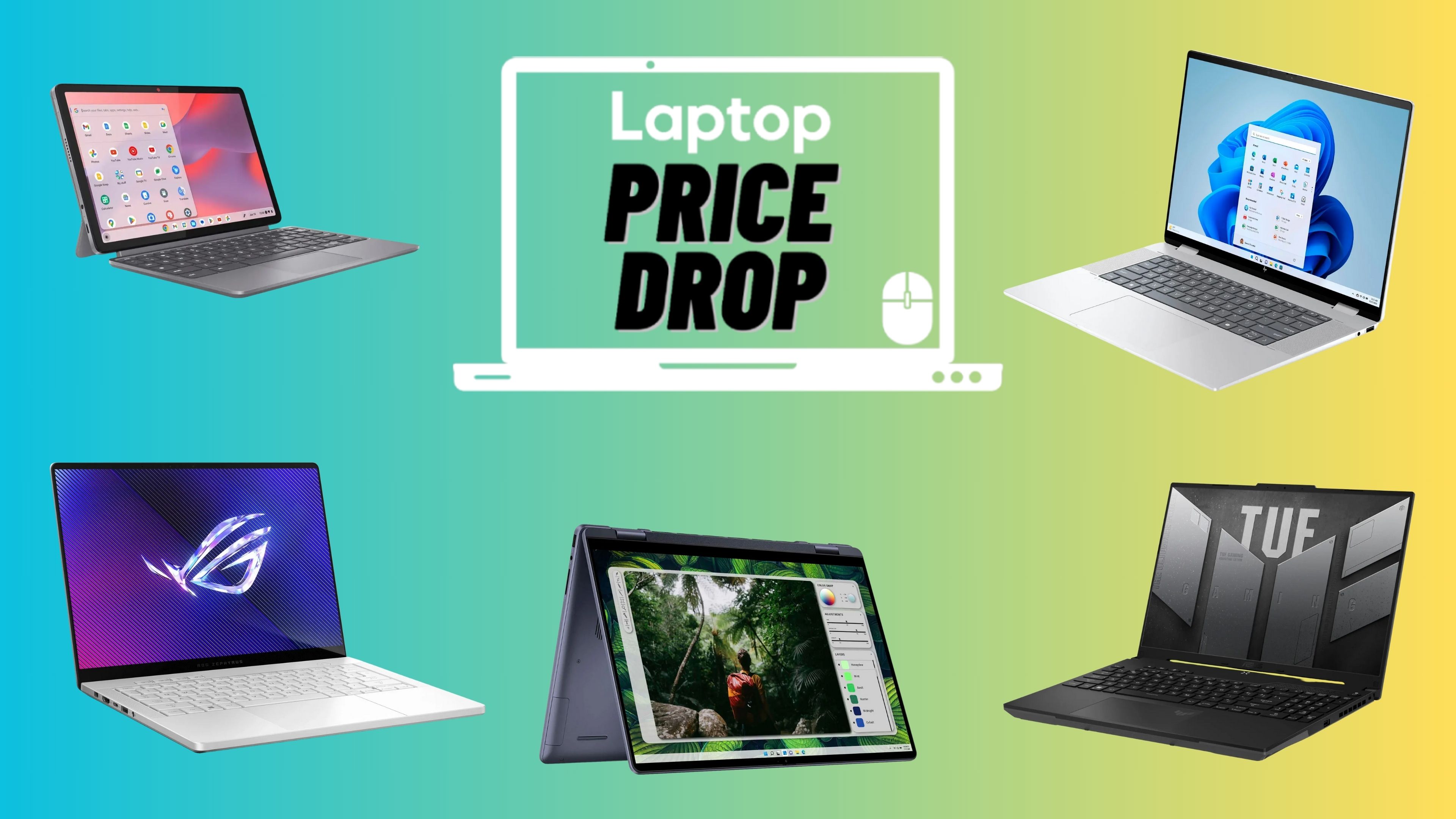Laptop Mag Verdict
A fantastic keyboard, 4G data capability, and a jaw-dropping display make this Android phone worth the premium.
Pros
- +
Eye-popping Super AMOLED Display
- +
Excellent slide-out keyboard
- +
Snappy performance
- +
Loud and rich speaker
- +
Media Hub service for movie and TV downloads
Cons
- -
Menu buttons nearly invisible until pressed
- -
Slower mobile hotspot than Evo 4G
- -
Some pixilation in camcorder footage
- -
No HDMI
Why you can trust Laptop Mag
How do you top one of the best smart phones ever made? That's the epic feat facing the Epic 4G, the priciest device yet in Samsung's Galaxy S family ($249) and the second smart phone for Sprint that taps into the carrier's growing 4G data network. This Android 2.1 phone comes ready to battle the powerful Evo 4G with it gorgeous Super AMOLED display and one of the most comfortable physical keyboards we've used on a mobile device. The Epic 4G will also soon deliver movie and TV show rentals and downloads, making it a great choice for media mavens on the go. This feature-packed has a few weaknesses, but overall it's Samsung's best Galaxy S series phone yet and yet another compelling reason to switch to Sprint.
Design
Like all other Galaxy S phones, it's all about the screen. The 4-inch Super AMOLED display dominates the front of the Epic 4G, surrounded by an all-black bezel. What makes this device different than its cross-carrier cousins is its unique slide-out keyboard, which packs five rows of backlit goodness. Because of this amenity, the 5.5-ounce Epic 4G weighs more than the Captivate for AT&T (4.5) and the Vibrant for T-Mobile (4.2) ounces. The Epic 4G is also understandably thicker than both of those phones (0.56 inches vs. 0.4 inches). We think this trade-off is worth it for the great typing experience, but you'll definitely notice the extra bulk in your pocket and when holding this device up to your head. On the other hand, the Epic 4G is lighter than the Evo 4G (6 ounces) and the Droid 2 (6 ounces), which also has a slide out keyboard.
For Sprint and Samsung the Super AMOLED screen was so important in this case that the capactive menu buttons beneath the display are blacked out when the screen is off. This treatment gives the phone a more modern appearance than the Evo 4G (whose buttons are always legible) but it sacrifices functionality for style. Overall, though, we prefer the rounded edges of the Epic 4G to the Evo 4G's boxy slate aeshetic, as well as the former's chrome accents.
The right side of the handset houses a small power button up top and a camera launch/shutter key on the bottom right. Up top you'll find the 3.5mm jacks and microUSB port (behind a sliding door), and the left side has a volume rocker. The black plastic back of the phone has specks of silver in it, a nice touch, and it's pretty easy to pop the cover off should you want to access the battery or memory card. On the back there's also a lens for the 5-MP autofocus camera with an LED flash beneath it. What you don't get that the Evo 4G has is an HDMI port and a built-in kickstand.

Click to enlarge
Display
If we had to choose between the Evo 4G's larger 4.3-inch screen and the Epic 4G's 4-inch display (both 800 x 480 pixels), we'd give the edge to Samsung's phone. Thanks to Super AMOLED technology, the picture has superior contrast, richer colors, and much better viewing angles. We wowed some friends by playing an HD video we captured of a toddler trying to chase a butterfly around some flowers. Some onlookers said it looked as though the picture was jumping off the screen. While some will prefer the Evo's larger panel, which not only shows larger images and text but whiter whites, the Epic 4G's superior display lives up to the rest of the Galaxy S family.
Keyboards
Those who feel that pairing a big 4-inch display with a physical keyboard is overkill should try the Epic 4G first. This layout is spacious but also provides excellent tactile feedback (and a satisfying click as you type). And unlike other slider phones we've tested with dedicated number rows, Samsung didn't position this one too close to the bottom of the display. At first we had trouble building up speed because of just how spacious this keyboard is, but overall it's a pleasure to use. We also appreciate that separate Menu, Back, Home and Search buttons flank the letters. Our only real complaint is that there isn't a dedicated @ symbol key like you'll find on the Motorola Droid and Droid 2; you have to press the Fn key first.
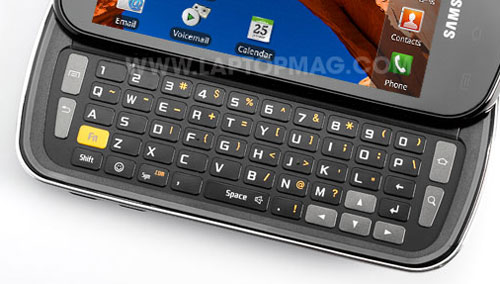
Click to enlarge
We didn't like the touch keyboard on the Epic 4G as much as the ones on the Captivate and Vibrant. Typing felt somewhat cramped in portrait mode, and we don't get why the space bar sits on the bottom right of the layout in landscape mode. In this mode we'd use the built-in Swype software, which lets you draw a line from letter to letter to form words.
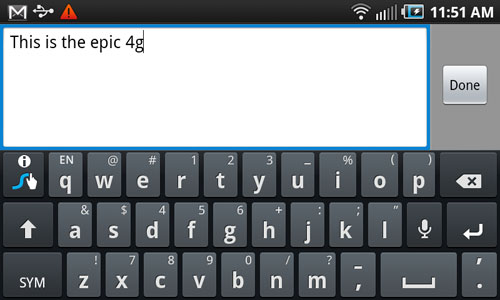
Click to enlarge
Interface
Like other Galaxy S phones, the Epic 4G takes a relatively light touch to skinning Android 2.1, giving you seven home screens to customize. On the main screen is the Google search box, and four main icons remain at the bottom of the screen when you swipe to the left or right: Phone, Contacts, Messaging, and Applications. You can always add shortcuts to other apps. Swiping down from the top of the display shows notifications but also four clickable buttons for Wi-Fi, Bluetooth, 4G, and GPS for quickly toggling these radios.
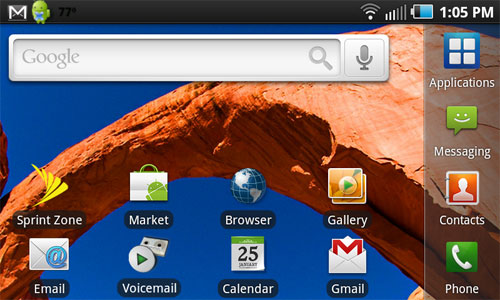
Click to enlarge
The two most notable Samsung widgets are Buddies Now and Feeds and Updates. Buddies Now lets you select contacts from your address book so you can see their latest Facebook status update and call them with a tap. Feeds and Updates aggregates the latest 16 updates from both Facebook and Twitter. What we didn't find was the Daily Briefing widget that's offered on both the Captivate and Vibrant, which on those phones delivers weather updates, news from AP Mobile, stock info from Yahoo Finance, as well as your daily calendar. Android widget choices include Google Latitude, Music, Picture Frame, and Power control.
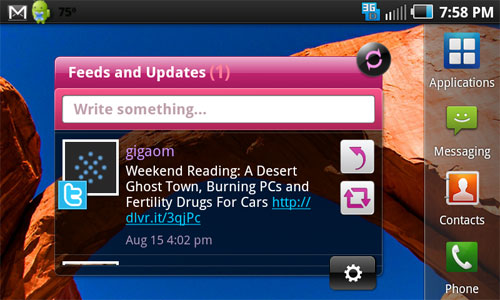
Click to enlarge
When you click Applications, you'll see why many people compare the Galaxy S line to the iPhone. This menu presents icons on a black background, and you swipe to the left to se more apps. Or you can switch to a list view. This presentation actually saves battery life because AMOLED screens use little to no power when displaying black.
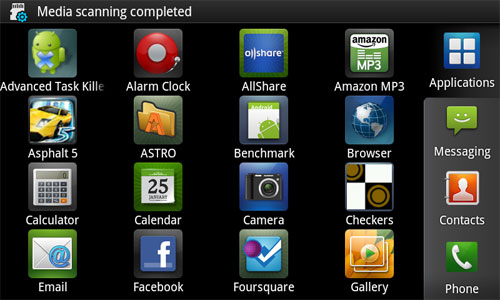
Click to enlarge
Specs and Performance
Packing Samsung's 1-GHz Hummingbird procesor, 1GB of ROM, and 512 MB of RAM, the Epic 4G is among the fastest smart phones available. In Linpack for Android, which measures floating point computing performance, this handset notched a score of 7.9 megaflops, compared to 8.2 for the Droid X and 6.7 for the Evo 4G. However, once we updated the Evo 4G to Android 2.2, that number jumped all the way up to 28. The Evo 4G also felt considerably faster after the update. We expect that the Epic 4G will see a similar boost once it gets the latest version of Google's OS later this year.
On the separate Benchmark app for Android, the Epic 4G scored 764 in the CPU section. The Droid X notched turned in a similar 778 and the Evo 4G running Android 2.1 notched 649. However, the Droid 2 and Evo 4G running the 2.2 OS scored 1706 and 2002. On the graphics portion of the test, the Epic 4G scored 30.9, comparable to the Droid 2 (30.7) and Droid X (31.49), but higher than the Evo 4G with Android 2.2 (25.6). In everyday use, the Epic 4G didn't feel quite as fast as the Evo 4G running Google's software, but it was generally quite responsive, whether we were opening apps or swiping through the photo gallery.
Web Surfing
The Epic 4G is the second smart phone in Sprint's lineup that can connect to the carrier's high-speed Mobile WiMax network, which is currently available in 48 cities. There are a lot of places in the U.S. where you can use this phone to get 3-6 Mbps downloads and 1 Mbps uploads, including Philadelphia, Las Vegas, Seattle, and Chicago. However, some of the biggest markets won't go online until later this year, such as Boston, New York, San Francisco, and Washington, D.C.
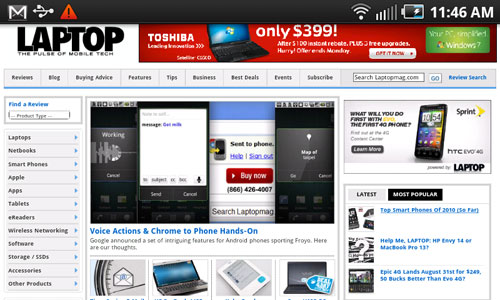
Click to enlarge
For our testing in New York and New Jersey we used Sprint's 3G EV-DO Rev. A network. The Epic 4G loaded Laptopmag.com in a reasonable 27 seconds, The New York Times mobile site in 8 seconds, and CNN's mobile site in 10 seconds. The Evo 4G was slightly faster, turning in times of 24, 7, and 7 seconds for the same sites. However, these quicker downloads could be due to HTC's device having Google's latest software, which offers better JavaScript performance. When we turned on Wi-Fi, the Evo 4G beat the Epic 4G by 5 seconds when loading ESPN Mobile Web. Both phones produced comparable download speeds when we used the Speedtest.net app (700 to 750 Kbps), but the Evo 4G's upload speeds were much higher (150 Kbps for Epic 4G vs. 383 Kbps for the Evo).
Mobile Hotspot App
Like the Evo 4G, the Epic 4G lets you connect multiple Wi-Fi devices to the phone at once using a bundled mobile hotspot app. Samsung's phone supports a maximum of five connections compared to eight for the Evo 4G, but we doubt many users will go beyond five gadgets anyway. The bigger drawback for the Epic 4G is its slower speeds when used as a mobile router. When tested head to head against the Evo using a ThinkPad X201s laptop, the Epic 4G never got above 440 Kbps downloads and averaged 110 Kbps on the upload. The Evo 4G got between 1.5 and 1.8 Mbps downloads and 250 Kbps uploads. This throughput delta remained constant when we surfed the web. The Epic 4G took 24 seconds to load The New York Times on our laptop, and 26 seconds to load CNN. The Evo 4G took 13 and 10 seconds, respectively.
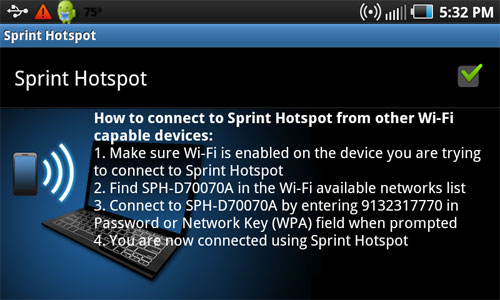
Click to enlarge
Apps
Although there are more than 70,000 apps now available in the Android Market, Samsung and Sprint pre-load the Epic 4G with a handful of goodies and carrier-branded services. The coolest app is a demo of Asphalt 5, a gripping racing game from Gameloft you control with the phone's six-axis motion sensor. (The paid version costs $4.99.) The Epic 4G also comes with an Alarm Clock, Calculator, Memo, Qik, Google Navigation, and ThinkFree Office for viewing, editing, and creating office documents.
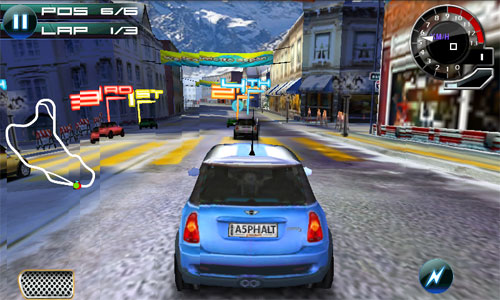
Click to enlarge
Pre-loaded Sprint apps include Sprint Football, Sprint TV, Sprint Navigation, and Nascar. In Sprint TV, a clip from Last Comic Standing played smoothly on the 4-inch display, even though it didn't fill the whole screen.
E-mail and Messaging
With the exception of the physical keyboard, there's nothing really unique about the Epic 4G when it comes to e-mail and text messaging. Setting up our Gmail account was a breeze, but we had trouble viewing attachments. (We'll update this review should we find a fix.)
Camera and Camcorder
The Epic 4G comes with a 5-MP autofocus camera and LED flash, capable of shooting crisp and color photos--so long as your subject isn't moving. A shot of flowers taken in sunlight was detailed and well saturated, as was a shot of a toddler (while resting). However, we wouldn't recommend using this phone for action shots. Images of two children playing around a table came out a little blurry, though clearer than the Evo 4G. Scene modes include Portrait, Landscape, Sports and Party/Indoor, all of which can assist in producing better looking images.

Click to enlarge
We used the 720p camcorder to capture a two-year old trying to coax a butterfly onto his finger. The footage looked mostly smooth when played back on a PC, but we noticed some pixilation in his face. In addition, the Epic 4G had trouble adjusting when moving from bright light into shadows. The issue became more pronounced when shooting indoors, even with a fair amount of overhead light.
To watch your videos on a TV, you'll need a TV or set-top box enabled with DLNA technology, which streams content over Wi-Fi. The AllShare app takes care of the rest. Still, many more sets have HDMI connections, and the Epic 4G lacks this port. Both the Evo 4G and Epic 4G have it.
Like the Evo 4G, the Epic 4G features a front-facing camera, but HTC's has a higher resolution than Samsung's (1.3 MP vs. VGA). When we made a video call between the two devices, the Evo 4G user reported that our face looked stretched. Audio remained mostly in sync, but the picture produced by the Evo 4G in this mode looked better.
Music and Video
The Epic 4G is made for rocking out, and that's because it's equipped with one of the best sounding speakers we've heard on a smart phone. Even when placed on a table the back-mounted speaker produced loud and rich audio when we cranked up The Shins' Wincing the Night Away. The audio player itself has a clean interface that's easy to navigate, and it imported album art easily from our PC. Like all Android phones, you can download new tracks over the air through Amazon MP3.
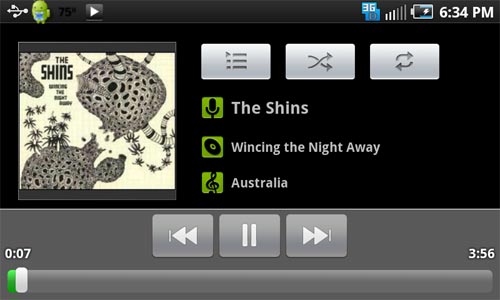
Click to enlarge
On the video front, the Epic 4G is more of a work in progress. Samsung is putting the finishing touches on Media Hub, a storefront for renting and buying TV shows and movies. The company says it has struck deals with most of the major studios and broadcasters, and a sneak peek of the interface looked pretty slick. This feature will give the Epic 4G a definite leg up on the Evo 4G as an entertainment device. Best of all, unlike other Galaxy S phones, you'll be able to start watching movies you've downloaded almost immediately over 4G, while the other devices will require a Wi-Fi connection.
Call Quality and Battery Life
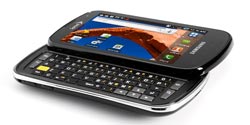
Click to enlargeCall quality on the Epic 4G was mostly clear during our tests in New York and New Jersey. The reception on Samsung's phone was slightly better than the Evo 4G (which sounded a bit fuzzy), but the latter phone was quicker to connect.
Over two days of use, the Epic 4G averaged between 9 and 10 hours of usage time before having to find an outlet. That's better endurance than the Evo 4G and slightly better than the Droid X. However, we noticed that the battery drained very quicky when using the mobile hotspot app or when shooting or viewing video. We'll update this review once we've run our web surfing battery test.
Pricing and Value
The Epic 4G comes standard with Sprint's Everything plan. For $79 per month (which includes a $10 premium data fee), you get unlimited calling to any mobile phone, as well as unlimited web and texting. For $30 more, you can use the phone as a mobile hotspot.
Verdict
With the arrival of the Samsung Epic 4G, Sprint now has the best one-two smart phone punch of any carrier. The Evo 4G is great for those who don't need a physical keybord and want perks like HDMI output and a built-in kickstand. It also has a more elegant interface and better widgets. However, the Epic 4G packs a more impressive display--despite its smaller size--and one of the best physical keyboards we've used into a lighter design.
Despite a somewhat sluggish mobile hotspot connection, we highly recommend this phone. And it will only get better as Samsung rolls out its Media Hub service and Sprint launches 4G in more cities. We also really like the Droid X for Verizon Wireless, which has a sharper camera and camcorder than the Epic 4G and a wider range of accessories. But if you want a phone that combines a great typing experience with an even better entertainment experience and blazing fast data, the Epic 4G is worth the extra $50 over the other Galaxy S phones and all other superphones.
Samsung Epic 4G (Sprint) Specs
| Bluetooth Type | Bluetooth 2.1 EDR with A2DP |
| Brand | Samsung |
| CPU | 1-GHz Samsung Cortex A8 |
| Camera Resolution | 5 MP |
| Carrier | Sprint |
| Company Website | www.samsung.com |
| Data | EV-DO Rev. A, Mobile WiMAX |
| Display (main) | 4-inches / 800 x 480 |
| Form Factor | QWERTY Slider |
| GPS | Yes |
| Internal Memory | 16GB microSD card |
| Memory Expansion Type | microSDHC |
| Networks | CDMA 800/1900MHz |
| Operating System | Android 2.1 |
| Photo formats supported | JPEG |
| RAM | 512MB |
| Size | 4.9 x 2.5 x 0.6 inches |
| Weight | 5.5 ounces |
| Wi-Fi | 802.11b/g/n |

